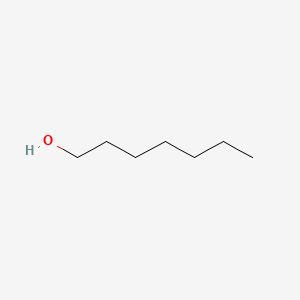| MeSH term | MeSH ID | Detail |
|---|---|---|
| Eye Burns | D005126 | 13 associated lipids |
| Ventricular Dysfunction, Left | D018487 | 33 associated lipids |
| Tachycardia, Ventricular | D017180 | 9 associated lipids |
| Heart Injuries | D006335 | 6 associated lipids |
| Wounds, Gunshot | D014948 | 2 associated lipids |
| Tachycardia, Ectopic Atrial | D013612 | 1 associated lipids |
n-heptanol
N-heptanol is a lipid of Fatty Acyls (FA) class. N-heptanol is associated with abnormalities such as Corneal Neovascularization. N-heptanol often locates in Epithelium and Structure of corneal epithelium. The related lipids are Heptanol.
Cross Reference
Introduction
To understand associated biological information of n-heptanol, we collected biological information of abnormalities, associated pathways, cellular/molecular locations, biological functions, related genes/proteins, lipids and common seen animal/experimental models with organized paragraphs from literatures.
What diseases are associated with n-heptanol?
n-heptanol is suspected in Corneal Neovascularization and other diseases in descending order of the highest number of associated sentences.
Related references are mostly published in these journals:
| Disease | Cross reference | Weighted score | Related literature |
|---|
Possible diseases from mapped MeSH terms on references
We collected disease MeSH terms mapped to the references associated with n-heptanol
PubChem Associated disorders and diseases
What pathways are associated with n-heptanol
There are no associated biomedical information in the current reference collection.
PubChem Biomolecular Interactions and Pathways
Link to PubChem Biomolecular Interactions and PathwaysWhat cellular locations are associated with n-heptanol?
Visualization in cellular structure
Associated locations are in red color. Not associated locations are in black.
Related references are published most in these journals:
| Location | Cross reference | Weighted score | Related literatures |
|---|
What functions are associated with n-heptanol?
There are no associated biomedical information in the current reference collection.
What lipids are associated with n-heptanol?
Related references are published most in these journals:
| Lipid concept | Cross reference | Weighted score | Related literatures |
|---|
What genes are associated with n-heptanol?
There are no associated biomedical information in the current reference collection.
What common seen animal models are associated with n-heptanol?
There are no associated biomedical information in the current reference collection.
NCBI Entrez Crosslinks
All references with n-heptanol
Download all related citations| Authors | Title | Published | Journal | PubMed Link |
|---|---|---|---|---|
| Rüdisüli A and Weingart R | Electrical properties of gap junction channels in guinea-pig ventricular cell pairs revealed by exposure to heptanol. | 1989 | Pflugers Arch. | pmid:2482959 |
| Leite R and Webb RC | Increased dilator response to heptanol and octanol in aorta from DOCA-salt-hypertensive rats. | 2001 | Pharmacology | pmid:11150920 |
| Gainaru C et al. | Shear-modulus investigations of monohydroxy alcohols: evidence for a short-chain-polymer rheological response. | 2014 | Phys. Rev. Lett. | pmid:24655283 |
| Bub G et al. | Spiral wave generation in heterogeneous excitable media. | 2002 | Phys. Rev. Lett. | pmid:11863783 |
| Smith DW et al. | Mice lacking NKCC1 have normal olfactory sensitivity. | 2008 | Physiol. Behav. | pmid:17719611 |
| Tantikanlayaporn D et al. | A diarylheptanoid phytoestrogen from Curcuma comosa, 1,7-diphenyl-4,6-heptadien-3-ol, accelerates human osteoblast proliferation and differentiation. | 2013 | Phytomedicine | pmid:23557993 |
| Chow SF et al. | Neurogenesis drives stimulus decorrelation in a model of the olfactory bulb. | 2012 | PLoS Comput. Biol. | pmid:22442645 |
| Nogi T et al. | A novel biological activity of praziquantel requiring voltage-operated Ca2+ channel beta subunits: subversion of flatworm regenerative polarity. | 2009 | PLoS Negl Trop Dis | pmid:19554083 |
| Rentero C et al. | Functional implications of plasma membrane condensation for T cell activation. | 2008 | PLoS ONE | pmid:18509459 |
| Nishizawa H et al. | Causes of abnormal Ca2+ transients in Guinea pig pathophysiological ventricular muscle revealed by Ca2+ and action potential imaging at cellular level. | 2009 | PLoS ONE | pmid:19768114 |
